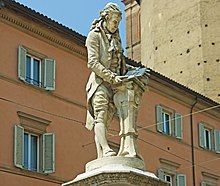Luigi galvani
Luigi Galvani (Bologna, Italy, September 9, 1737-ibid., December 4, 1798) was a physician, Italian physiologist and physicist, his studies allowed him to decipher the electrical nature of galvanization, founding electrochemical engineering that studies electric batteries, as well as discovering the nervous impulse, founding biophysics. He was a member of the Venerable Third Order (now called the Secular Franciscan Order).
Starting around 1780, Galvani began to include in his lectures small practical experiments that demonstrated to students the nature and properties of electricity. In one of these experiences, the scientist demonstrated that by applying a small electrical current to the spinal cord of a dead frog, large muscle contractions were produced in its limbs. These discharges could cause the legs (even separated from the body) to jump just like when the animal was alive.
The doctor had discovered this phenomenon while dissecting a frog's leg, his scalpel accidentally touching a bronze hook from which the leg dangled. There was a small shock, and the leg contracted spontaneously. Through repeated and consistent experiments, Galvani became convinced that what he was seeing were the results of what he called "animal electricity." Galvani identified animal electricity with the life force that animated the frog's muscles, and invited his colleagues to reproduce and confirm what he did.
This was done at the University of Pavia by Galvani's colleague, Alessandro Volta, who stated that the results were correct but was not convinced by Galvani's explanation. Volta's questions made Galvani see that there was still a lot to do. The main obstacle to his explanation was the ignorance of the reasons why the muscle contracted when receiving electricity. The obvious theory was that the nature of the nerve impulse was electrical, but it remained to be proven.
The physiologist called this way of producing energy 'bioelectrogenesis'. Through numerous and spectacular experiments—such as electrocuting human corpses to make them dance the "dance of tonic convulsions"—he came to the conclusion that the necessary electricity did not come from outside, but was generated inside. of the living organism itself, which, once dead, continued to retain the ability to conduct the impulse and react to it accordingly.
Basis of an entire science
With his explanations, Galvani had finally dismissed the old theories of Descartes, who thought that nerves were just pipes that transported fluids. He had finally understood the true nature of the nervous system, as a highly efficient electrical device.
Unfortunately, in Galvani's time there were no measuring instruments capable of determining the very low tension that circulates through the nerves: the task necessarily remained in the hands of later scientists, endowed with more advanced technology.
Luigi Galvani's studies inaugurated an entire science that did not exist until then: neurophysiology, the study of the functioning of the nervous system on which neurology is based..
Last years
Galvani kept his chair as full professor of the Chair of Anatomy at his university for 35 years (1762-1797). In a short time, his enormous capacity for surgery also earned him the appointment as head of obstetrics at the Institute of Sciences, of which he was also appointed director in 1772.
However, when all the university professors were "invited" to sign an oath of allegiance to the foreign emperor Napoleon Bonaparte when he invaded Italy, with enormous integrity and nationalism, Galvani refused to do so, and as a consequence he was immediately dismissed in all his charges.
He died less than a year later.
Consequences
From the publication in 1791 of his book De viribus electricitatis in motu musculari commentarius, the galvanic phenomenon became public, known throughout the world and began to be studied by a large number of scientists.
Beyond the obvious foundational nature of Galvani's discovery with respect to modern neurosciences, it had other no less far-reaching consequences. His dispute with Alessandro Volta about the nature of electricity suggested to the latter the design and development of the first voltaic battery, while stimulating other researchers such as Benjamin Franklin and Henry Cavendish to deepen their studies on the subject.
The theory of galvanism, popular in the early 19th century, stems from experiments conducted by Galvani.
On the literary side, teen writer Mary Shelley's novel Frankenstein reflects, in a terrifying context, the impressive experiments of Galvani and his followers on the apparent "reanimation" corpses through the application of electric shocks. Mary Shelley makes no reference to the method by which Frankenstein manages to create a living being.
Eponymy
- Galvanism
- Galvanic corrosion
- Galvanometer
- Galvanized
- The lunar crater Galvani bears this name in his memory.
Contenido relacionado
John edwards
Pearlette Louisy
Michael Graves

